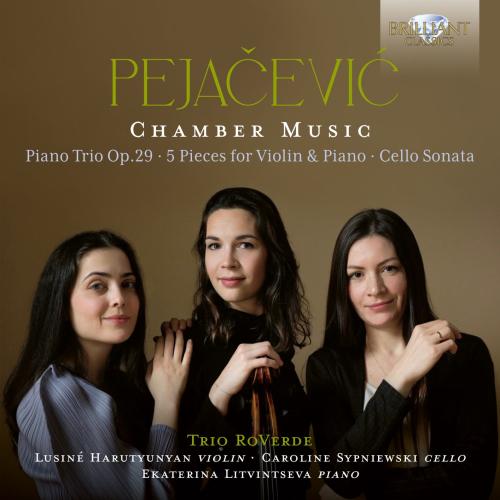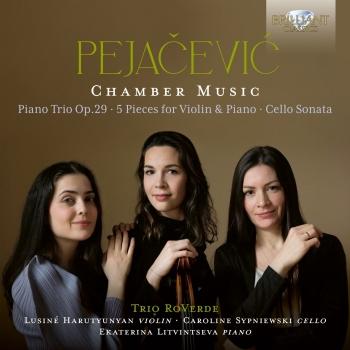
Pejačević: Chamber Music Trio RoVerde
Album info
Album-Release:
2024
HRA-Release:
03.01.2024
Label: Brilliant Classics
Genre: Classical
Subgenre: Chamber Music
Artist: Trio RoVerde
Composer: Dora Pejačević (1885-1923)
Album including Album cover Booklet (PDF)
- Dora Pejačević (1885 - 1923): Cello Sonata in E Minor, Op. 35:
- 1 Pejačević: Cello Sonata in E Minor, Op. 35: I. Allegro Moderato 07:25
- 2 Pejačević: Cello Sonata in E Minor, Op. 35: II. Scherzo. Allegro 06:54
- 3 Pejačević: Cello Sonata in E Minor, Op. 35: III. Adagio Sostenuto 07:27
- 4 Pejačević: Cello Sonata in E Minor, Op. 35: IV. Allegro Comodo 06:57
- Canzonetta, Op. 8:
- 5 Pejačević: Canzonetta, Op. 8 03:12
- Menuett, Op. 18:
- 6 Pejačević: Menuett, Op. 18 04:01
- Romance, Op. 22:
- 7 Pejačević: Romance, Op. 22 02:26
- Elegy, Op. 43:
- 8 Pejačević: Elegy, Op. 43 03:32
- Meditation, Op. 51:
- 9 Pejačević: Meditation, Op. 51 02:42
- Piano Trio, Op. 29:
- 10 Pejačević: Piano Trio, Op. 29: I. Allegro con Moto 10:32
- 11 Pejačević: Piano Trio, Op. 29: II. Scherzo. Allegro 06:39
- 12 Pejačević: Piano Trio, Op. 29: III. Lento - Allegretto 08:15
- 13 Pejačević: Piano Trio, Op. 29: IV. Finale. Allegro Risoluto 09:21
Info for Pejačević: Chamber Music
The pianist Ekaterina Litvintseva won critical praise for her solo album on Piano Classics (PCL10226) of piano music by Dora Pejačević: ‘You owe it to yourself to make the acquaintance of Dora Pejačević if you haven’t done so already.’ (Fanfare, May 2022)
With her colleagues in Trio RoVerde, she now turns to the Croatian composer’s chamber music. The Cello Sonata dates from 1913, the same year as Pejačević wrote the first piano concerto by any Croatian composer. Like Brahms’s First Cello Sonata and Elgar’s Cello Concerto, it is cast in a moody E minor, with a yearning character are established from the outset by a long-limbed cantabile melody for the cellist. Pejačević proceeds to develop a passionate dialogue between cello and piano through an assured handling of sonata form.
The following sequence of miniatures for violin and piano evokes the world of the salon in their titles, but the Schumannesque warmth of the Romanze Op.22, from 1907, is replaced by a style at once more wistful and refined by the time of the Elegie, which she wrote in the same pivotal year (1913) as the Cello Sonata. From seven years later, the Meditation Op.51 makes no retreat into solipsism but paints a three-minute sketch of a new and uncertain world.
From 1910, the C major Piano Trio returns us to safer ground. Pejačević demonstrates a notable sensitivity in writing for a tricky combination of instruments: strong melodic writing for the string instruments counterbalances the weight of the piano part, which is in any case deftly pointed and touched by the composer’s experience as a performer. If Pejačević’s chamber music has not taken its place in the standard repertoire of late-Romanticism, it is our loss, and one that an increasing number of performances and recordings such as this one are belatedly redressing.
Trio RoVerde:
Lusiné Harutyunyan, violin
Caroline Sypniewski, cello
Ekaterina Litvintseva, piano
The RoVerde Trio
was actually formed by chance thanks to a meeting of the three artists on the recording of Beethoven's Concerto for Piano, Violin and Cello Op. 56, and thanks to their synergistic collaboration they continue to work. Composed of Lusiné Harutyunyan (violin), Caroline Sypniewski (cello) and Ekaterina Litvintseva (piano), they perform throughout Europe. The name "RoVerde" was coined after the name of Rob Groen, who is the manager and the founder of the group.
Booklet for Pejačević: Chamber Music












